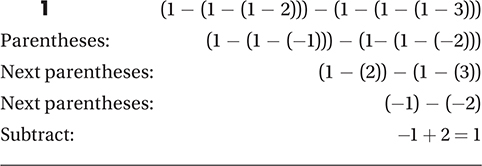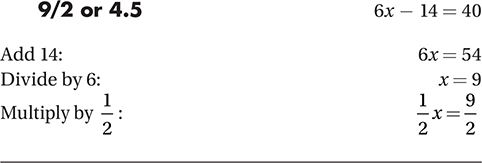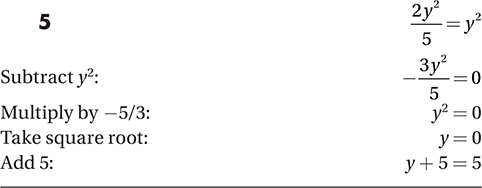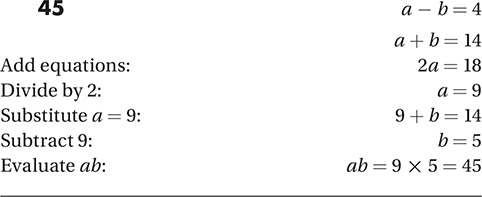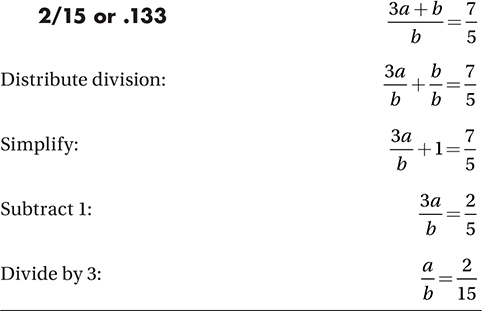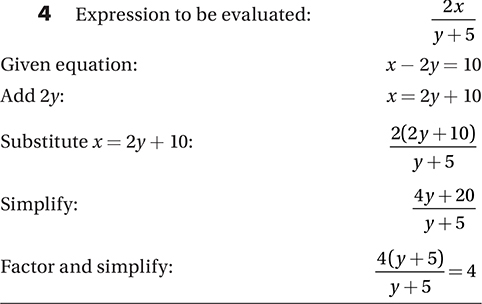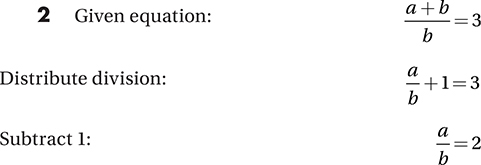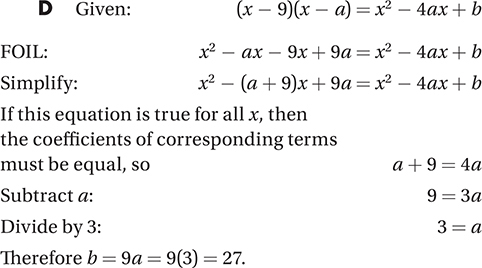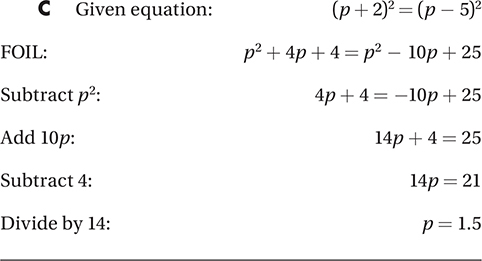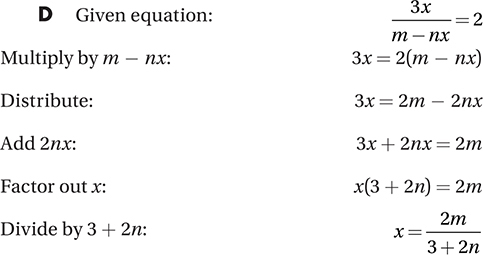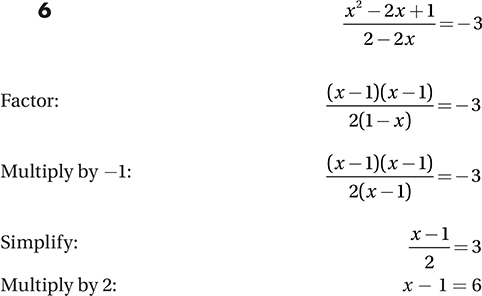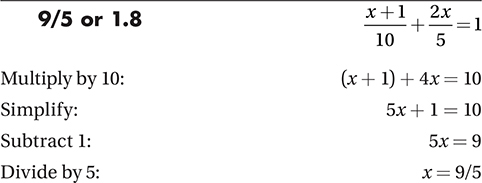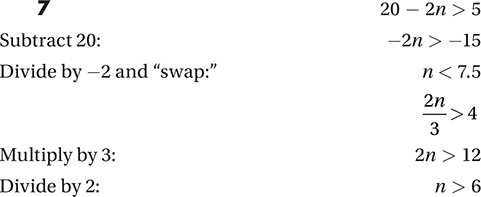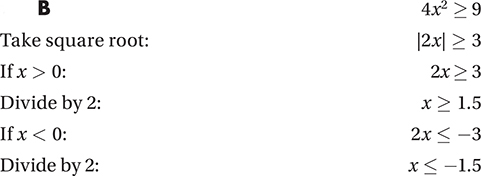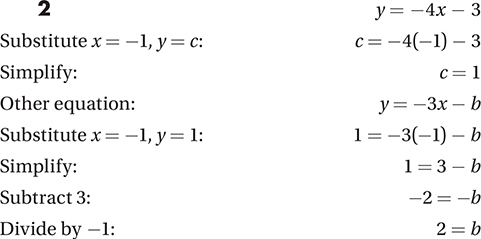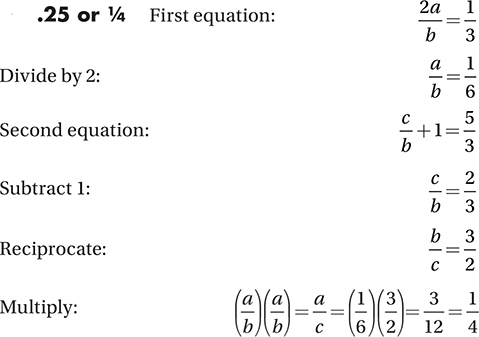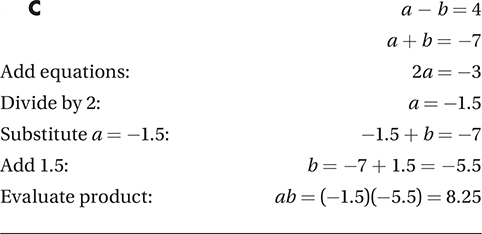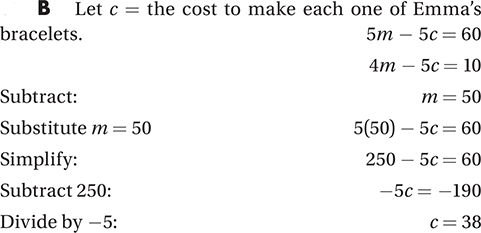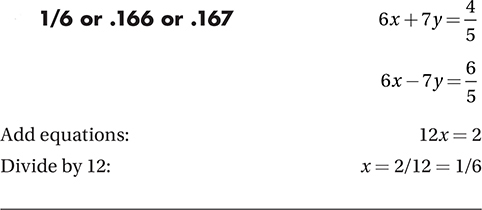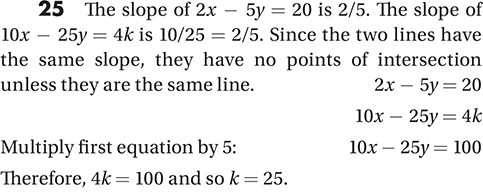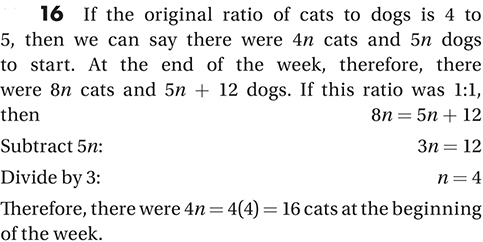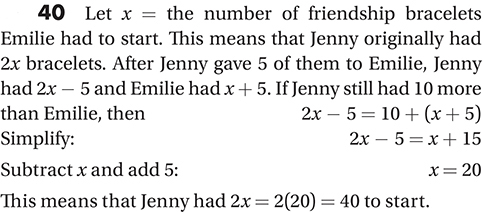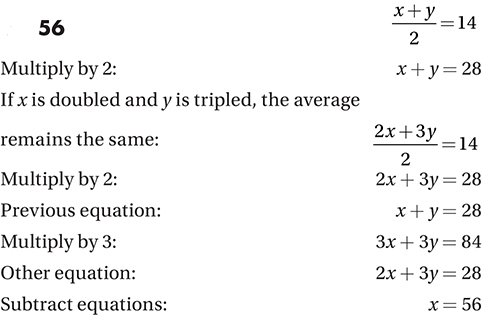CHAPTER 6
2. The Order of Operations and Laws of Arithmetic
5. Constructing and Interpreting Linear Equations
6. Solving Equations with the Laws of Equality
8. Understanding Inequalities and Absolute Values
9. Solving Inequalities with the Laws of Inequality
11. Constructing, Graphing, and Interpreting Linear Systems
12. Solving Systems by Substitution
13. Solving Systems by Linear Combination
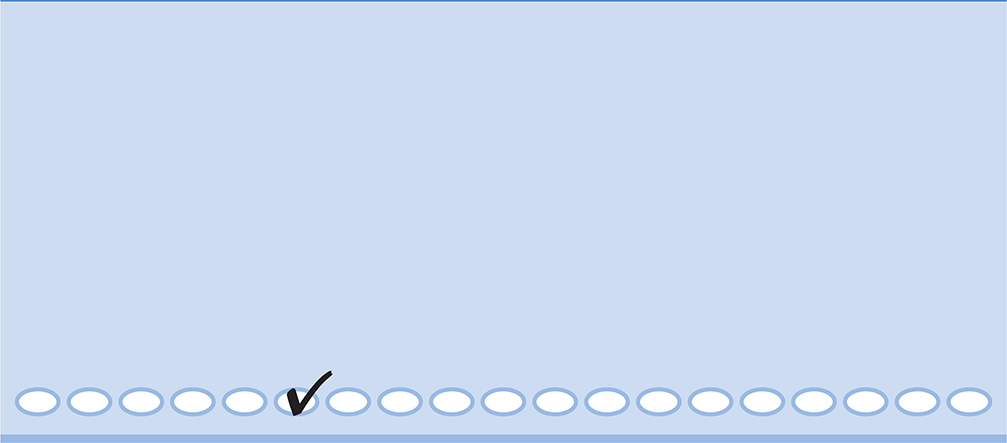
The SAT Math: Heart of Algebra
Why is algebra so important on the SAT Math test?
About 36% (21 out of 58) of the SAT Math questions fall under the category called the “Heart of Algebra.” Questions in this category test your ability to
analyze, fluently solve, and create linear equations, inequalities, [and] systems of equations using multiple techniques.
These questions will also assess your skill in
interpreting the interplay between graphical and algebraic representations [and] solving as a process of reasoning.
The specific topics include
• creating and solving linear equations in one and two variables
• graphing and interpreting linear equations
• creating, interpreting, and solving linear systems
• graphing and solving inequalities and systems of inequalities
• interpreting and solving algebraic word problems
Why are these skills important?
Algebra is an essential tool of quantitative analysis not only in math but also in subjects like engineering, the physical sciences, and economics. When describing the relationships between or among different quantities, or exploring the nature of unknown quantities, algebra provides essential tools for analyzing and solving problems. Most colleges consider fluency in algebra to be a vital prerequisite to a college-level liberal arts curriculum.
Sound intimidating? It’s not.
If you take the time to master the four core skills presented in these 13 lessons, you will gain the knowledge and practice you need to master even the toughest SAT Math “Heart of Algebra” questions.
Lesson 1: Word Problems
Breaking Down Word Problems
Algebraic word problems aren’t so tough if you break them down into four basic steps:
1. Read the whole problem and identify the relevant quantities.
2. Represent those quantities with algebraic expressions.
3. Translate the facts into equations.
4. Solve the equations for the relevant quantities.
Corrine drives d miles to her office at an average speed of 50 miles per hour. Returning home, she travels by the same route and averages 60 miles per hour. If her trip home is 10 minutes shorter than her trip to her office, what is the value of d?

(Medium-hard) The challenge with word problems is that we have to set up the equations ourselves. Let’s walk through the steps.
1. Identify: In this problem, there are six quantities:
• the speed from home to office
• the distance from home to office
• the time it takes to get from home to office
• the speed from office to home
• the distance from office to home
• the time it takes to get from office to home
That’s a lot, so let’s simplify.
2. Represent. If we think a bit, we can see that we have enough information to express all six quantities in terms of just two unknowns. If we represent the total time, in hours, it takes her to get home as t, then we can arrange all the information in a simple table:

3. Translate. Now we need to apply a basic formula:
distance = average speed × time
This gives us two equations with two unknowns:

4. Solve. So now we have to solve this 2-by-2 system of equations. (If you’re feeling rusty on this topic, don’t worry. We will discuss systems in more detail in Lessons 11–12) Since the unknown d is isolated in both equations, let’s substitute.

Since t represents the time in hours it took Corrine to get home, it took her 5/6 hours (or 50 minutes) to get home and 5/6 hour + 1/6 hour = 1 hour to get to her office. But the question asks for the distance from her home to her office, so we need to plug the values just calculated into one of the equations to find d.

Lesson 2: The Order of Operations and Laws of Arithmetic
The Order of Operations: PG-ER-MD-AS
You probably learned that the order of operations is PEMDAS, but this isn’t technically true: there is a GERM in the order of operations. When simplifying complicated expressions, the order to follow is
1. PG: parentheses and other grouping symbols (inside out)
2. ER: exponents and roots (inside out)
3. MD: multiplication and division (left to right)
4. AS: addition and subtraction (left to right)
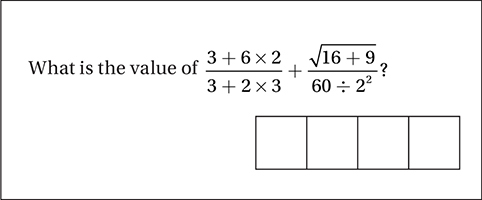
(Easy)
PG: Since this expression contains no parentheses, we don’t have to worry about “grouped” operations, right? Wrong! Remember that fraction bars and radicals are also "grouping symbols"!
In other words, we can think of the expression like this:

If the parentheses only contain one operation, then we do that operation:

If they contains more than one operation, then we have to move on to the next step.
ER: Do any of the parentheses contain exponents or roots? Yes, so we must perform those operations next:

MD: Next, we do any multiplication or division from left to right inside the parentheses:

AS: Now we do any addition and subtraction left in the parentheses:

Now that all the “grouped” operations are finished, we run through the order again to finish up. Exponents or roots? No. Multiplication or division? Yes:
1.6666… + 0.3333…
Addition or subtraction? Yes: 1.6666… + 0.3333… = 2
What is the sum of the first 100 positive integers?

(Hard) Here, following PGERMDAS and adding from left to right would be, shall we say, less than convenient: it requires 99 computations! Even with a calculator, this would be a pain. But here is a much simpler method:
Original expression: 1 + 2 + 3 + 4 + ... + 97 + 98 + 99 + 100
Rearrange and regroup so that we add from “outside in”: (1 + 100) + (2 + 99) + (3 + 98) + ... + (50 + 51)

This gives us exactly the same result as PGERMDAS would give, but with just a few simple calculations. But we changed the rules! We didn’t add strictly from left to right as PGERMDAS commands.
This shows that it helps to move beyond the order of operations and understand the Laws of Arithmetic.
The Laws of Arithmetic
The Laws of Arithmetic go beyond the order of operations and reveal important properties of the operations that can help you to simplify many problems.
The Commutative Laws
When adding or multiplying, order doesn’t matter.
3 + 8 + 12 = 8 + 12 + 3
2 × 6 × 50 = 2 × 50 × 6
The Associative Laws
When adding or multiplying, grouping doesn’t matter.
26 + (74 + 37) + 63 = (26 + 74) + (37 + 63)
2 × (3 × 4) × 5 = (2 × 3) × (4 × 5)
The Distributive Law
When a grouped sum/difference is being multiplied/divided, you may “distribute” the multiplication/division. For example,
15(20 + 8) = 15(20) + 15(8) = 300 + 120 = 420

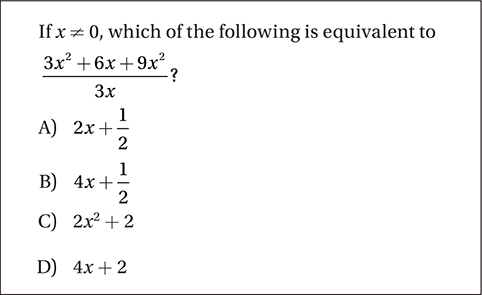
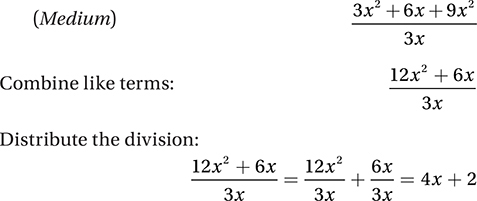
So, the correct answer is D.
Don’t "Overdistribute"
The Distributive Law does not allow you to just “take any operation outside of parentheses and drag it inside.” For example, do the arithmetic to convince yourself that
3(2 × 5) ≠ (3 × 2) × (3 × 5)
(2 + 3)2 ≠ 22 + 32
Which expression is equivalent to 3(34 × 53)? (No calculator.)
A) 3(34) × 3(53)
B) 94 + 153
C) 94 × 153
D) 35 × 53
(Medium-hard) Since the grouped expression is not a sum, but a product, we can’t use the Distributive Law here. We can, however, use the Associative Law of Multiplication:
3(34 × 53) = (3 × 34) × 53 = 35 × 53. Therefore, the correct answer is D.
Know How to FOIL
Whenever you multiply polynomials, you must use the Distributive Law multiple times. When multiplying two binomials, you can use the shortcut called FOILing.
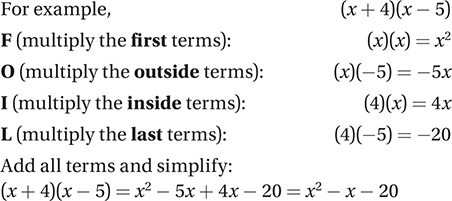
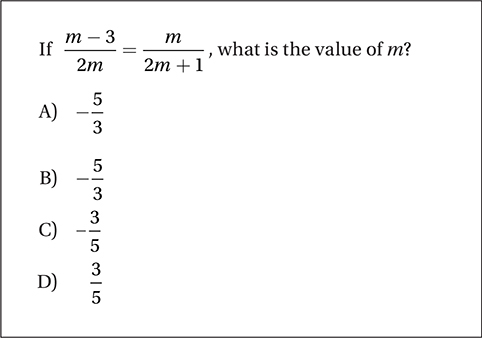
(Medium) First use the Law of Cross-Multiplication (Chapter 7, Lesson 9) to simplify the given equation.
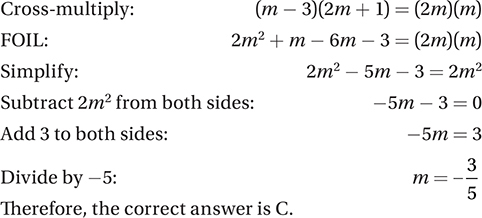
If (2x + 2)(x + a) = 2x2 + bx + c for all values of x, which of the following must be equal to b + c?
A) a + 2
B) 2a + 2
C) 3a + 2
D) 4a + 2
(Medium-hard)

If this equation is true for all values of x, then the two sides of the equation are identical quadratics (Chapter 8, Lesson 4). Clearly the first terms, 2x2, match on the two sides, but the other two pairs of corresponding terms must match as well.

Therefore, b + c = (2a + 2) + 2a = 4a + 2, and so the correct answer is D.
Exercise Set 1 (No Calculator)
(1 − (1 − (1 − 2))) − (1 − (1 − (1 − 3))) =

When 14 is subtracted from 6 times a number, 40 is left. What is half the number?

Four consecutive even numbers have a sum of 76. What is the greatest of these numbers?


What number decreased by 7 equals the opposite of five times the number?

If 5d + 12 = 24, then 5d − 12 =


The product of x and y is 36. If both x and y are integers, then what is the least possible value of x − y?
A) −37
B) −36
C) −35
D) −9
If a factory can manufacture b computer screens in n days at a cost of c dollars per screen, then which of the following represents the total cost, in dollars, of the computer screens that can be manufactured, at that rate, in m days?

Which of the following is equivalent to 5x (2x × 3) − 5x2 for all real values of x?
A) 5x2 + 15x
B) 25x2
C) 5x2 − 15x
D) 10x2 × 15x − 5x2
The symbol Ω represents one of the fundamental operators: +, –, ×, or ÷. If (x Ω y) × (y Ω x) = 1 for all positive values of x and y, then Ω can represent
A) +
B) ×
C) –
D) ÷
Exercise Set 1 (Calculator)
The difference of two numbers is 4 and their sum is 14. What is their product?

If x + y − 1 = 1 − (1 − x), what is the value of y?

If 3x2 + 2x = 40, then 15x2 + 10x =

Ellen is currently twice as old as Maria, but in 6 years, Maria will be  as old as Ellen. How old is Ellen now?
as old as Ellen. How old is Ellen now?

If 2x − 2y = 5 and x + y = 6, what is the value of x2 − y2?

On a typical day, a restaurant sells n grilled cheese sandwiches for p dollars each. Today, however, the manager reduced the price of grilled cheese sandwiches by 30% and as a result sold 50% more of them than usual. Which of the following represents the revenue for today’s grilled cheese sandwich sales, in dollars?
A) 0.5np − 0.3
B) 1.05np
C) 1.20np
D) 1.50np
For all real numbers x and y, 4x(x) − 3xy(2x) =
A) 12x2y(x − 2y)
B) 2x2(2 − 3y )
C) 2x2(2 + 3y )
D) 4xy(x − 3y)
If a = 60(99)99 + 30(99)99, b = 99100, and c = 90(90)99, then which of the following expresses the correct ordering of a, b, and c?
A) c < b < a
B) b < c < a
C) a < b < c
D) c < a < b
Which of the following statements must be true for all values of x, y, and z?
I. (x + y) + z = (z + y) + x
II. (x − y) − z = (z − y) − x
III. (x ÷ y) ÷ z = (z ÷ y) ÷ x
A) I only
B) I and II only
C) I and III only
D) II and III only
Carlos began with twice as much money as David had. After Carlos gave $12 to David, Carlos still had $10 more than David. How much money did they have combined at the start?
A) $34
B) $68
C) $102
D) $108
EXERCISE SET 1 ANSWER KEY
No Calculator
3. 22 Let n be the least of these numbers. The sum of four consecutive even numbers is therefore n + (n + 2) + (n + 4) + (n + 6) = 76.

8. C If xy = 36 and x and y are integers, then x and y are both factors of 36. In order to minimize the value of x − y , we must find the greatest separation between x and y . The greatest separation between a factor pair is 1 − 36 = −35.
9. A We should regard this as a "conversion" problem from m days into a corresponding number of dollars.

Remember: The Law of Distribution does not apply in the first step, because the grouped expression doesn’t include addition or subtraction.
11. D The simplest approach is perhaps to choose simple values for x and y , like 2 and 3, and see which operator yields a true equation. Since (2 ÷ 3) × (3 ÷ 2) = 1, the answer is D.
Calculator
15. 12 Let e = Ellen’s current age and m = Maria’s current age.
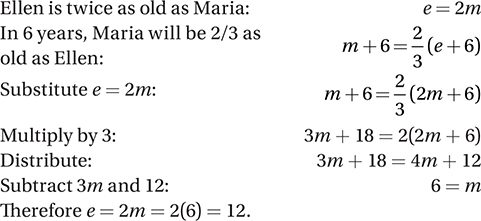
Alternately, we could solve the system using either substitution or linear combination and get x = 4.25 and y = 1.75, and evaluate x2 − y2 = (4.25)2 − (1.75)2 = 18.0625 − 3.0625 = 15.
17. B The revenue is equal to the number of items sold times the price per item. If the restaurant typically sells n sandwiches per day, but today sold 50% more, it sold 1.5n sandwiches. If the price p was reduced 30%, today’s price is 0.70p. Therefore, the total revenue is (1.5n)(0.70p) = 1.05np.
19. D Although a calculator is permitted for this question, most calculators will give an "overflow error" when trying to calculate numbers like 99100, because they’re just too large. However, comparing these numbers is straightforward if we can express them in a common format.

20. A Only statement I is true, by the Commutative and Associative Laws of Addition. Choosing simple values like x = 1, y = 2, and z = 3 will demonstrate that statements II and III do not yield true equations.
21. C Let x = the number of dollars David had to start. If Carlos started with twice as much money as David, then Carlos started with 2x dollars. After Carlos gave David $12, Carlos had 2x − 12 dollars and David had x + 12 dollars. If Carlos still had $10 more than David, then

Therefore, David started with $34 and Carlos started with 2($34) = $68, so they had $34 + $68 = $102 combined to start.
Lesson 3: Simplifying Expressions
The Law of Substitution
Perhaps the most important problem-solving tool in algebra is the Law of Substitution. If two things are equal, you can always substitute one for the other.
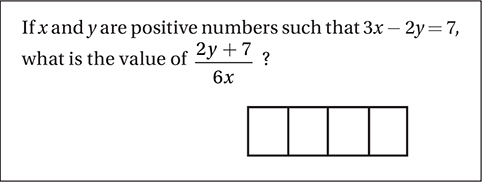
(Medium) Notice that 2y and 7 appear in both the equation and in the expression. Let’s take advantage of that.

Since 2y + 7 appears in the fraction, we may replace it with 3x by the Law of Substitution and simplify:

Also, we can just plug in values for x and y that satisfy the equation. Notice that x = 3 and y = 1 is a solution because 3(3) − 2(1) = 7, and so we can evaluate the fraction by plugging in these numbers: (2(1) + 7)/6(3) = 9/18 = 1/2, or 0.5.
Simplifying Percent Problems
To increase a number by a%, just multiply by (100 + a)%, and to decrease a number by a%, just multiply by (100 − a)%. For instance, to increase a number by 13%, multiply by 1.13, and to decrease a number by 13%, multiply by 0.87.
The population of sea urchins in a particular reef has been decreasing by 10% per year for the last three years. What is the total percent decrease in this population over the past three years? (Disregard the % symbol when gridding.)

(Medium) To decrease a quantity by 10%, we multiply by 0.90. If the original population is n , then after three years the population will be (0.90)(0.90)(0.90)n = 0.729n. Since this is 72.9% of the original population, the total percent decrease is (100 − 72.9)% = 27.1%.
Bonus question: Why is the answer not 3(10%) = 30%?
Simplifying Operations
Every operation can be expressed in terms of its inverse. For instance, subtracting –16 is the same as adding 16, and dividing by 4 is the same as multiplying by 1/4. These equivalences can help you to simplify calculations.
Increasing a positive number by 25% and then decreasing this result by 50% is equivalent to dividing the number by
A) 1.33
B) 1.50
C) 1.60
D) 1.65
(Medium) Let’s call the positive number n. If we increase this by 25%, we get 1.25n. If we decrease this by 50%, we get (0.50)(1.25n) = 0.625n.
Multiplying by 0.625 is equivalent to dividing by its reciprocal, and 1/0.625 = 1.60. Therefore, the correct answer is C.
Important Factoring Identities

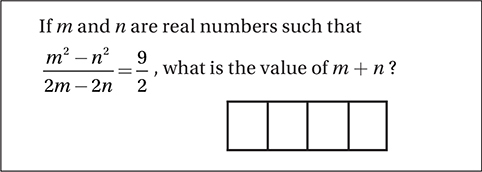
(Easy) As a rule, we should simplify any complicated-looking expressions, but also keep an eye on what the question is asking. Here, we need to remember that we are asked to find the value of m + n and not the values of m and n individually.
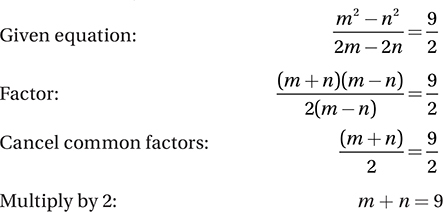
Bonus: What ordered pair (m, n) has a sum of 9 but is not a solution to the equation?
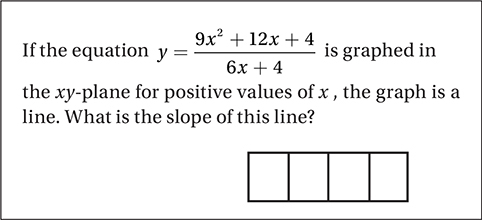
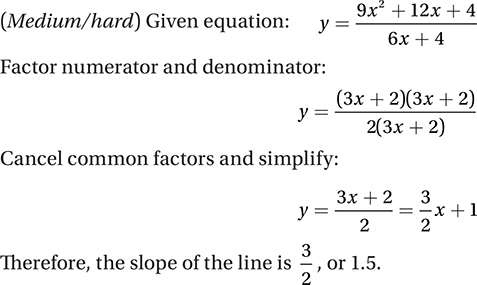
Look for Patterns
Don’t be intimidated by complex expressions. Just look for simple patterns that allow you to simplify with the Law of Substitution.
If x2 + 4x + 5 = y and z = x + 2, which of the following expresses y in terms of z?
A) y = z2 + 1
B) y = z(z + 3)
C) y = z2 + 5
D) y = (z + 2)2 + 1
(Medium) The fact that (x + 2)2 = x2 + 4x + 4 allows for a clever substitution:
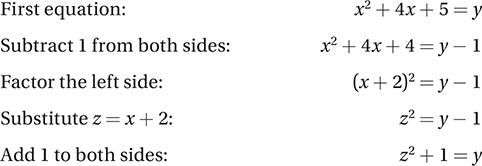
Therefore, the correct answer is A.
Lesson 4: Conversions
Conversion Factors
A conversion factor is a fraction in which the numerator and the denominator are equal. For instance, 1 mile is equal to 1.609 kilometers, so  is a conversion factor for converting kilometers to miles, and
is a conversion factor for converting kilometers to miles, and  is a conversion factor for converting miles to kilometers.
is a conversion factor for converting miles to kilometers.
Using Conversion Factors
When converting quantities, make sure that the units cancel properly, like common factors. For instance, if you’ve just run a 10-km race and want to know how many miles you’ve run, the conversion is

Notice that kilometers must go in the denominator of the conversion factor in order to cancel the original kilometers.
Niko is 27 inches shorter than his father, who is 5 feet 10 inches tall. How tall is Niko? (1 foot = 12 inches)
A) 3 feet 4 inches
B) 3 feet 6 inches
C) 3 feet 7 inches
D) 3 feet 10 inches
(Easy) If Niko’s father is 5 feet 10 inches tall, he is 5 feet × (12 inches/1 foot) + 10 inches = 70 inches tall. If Niko is 27 inches shorter, he is 70 − 27 = 43 inches tall, which is equivalent to 43 inches × (1 foot/12 inches) = 3 7/12 feet, or 3 feet 7 inches, so the correct answer is C.
Universal vs. “Problem-Specific” Conversions
Sometimes the equivalence shown in a conversion factor is universal (for instance, 1 pound is always equal to 16 ounces) and sometimes it is problem-specific. For instance, if a problem says that a machine pumps at a rate 3 gallons per hour, pumping for 1 hour is equivalent to pumping 3 gallons in the context of this problem.
If a factory can manufacture b computer screens in n days at a cost of c dollars per screen, then which of the following represents the total cost, in dollars, of the computer screens that can be manufactured, at that rate, in m days?

(Medium) We can look at this as a problem of converting days to dollars. We are told that this factory works for m days, so let’s write this down, including units, and multiply by the conversion factors until we convert to dollars:

Notice that all of the units cancel except for dollars in the numerator. So, the correct answer is A.
Exercise Set 2 (No Calculator)
If bag A weighs 4 pounds 5 ounces and bag B weighs 6 pounds 2 ounces, how much heavier, in ounces, is bag B than bag A? (1 pound = 16 ounces)



If a − b = 4 and a2 − b2 = 3, what is the value of a + b?

If 6 gricks are equivalent to 5 merts, then 2 merts are equivalent to how many gricks?

If the function {x} is defined by the equation {x} = (1 − x)2, what is the value of {{4}}?


(x − 9)(x − a) = x2 − 4ax + b
In the equation above, a and b are constants. If the equation is true for all values of x, what is the value of b?
A) −27
B) −12
C) 12
D) 27
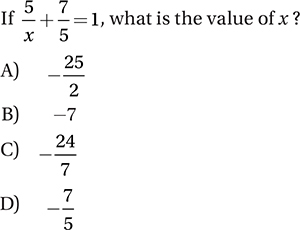
(p + 2)2 = (p − 5)2
The equation above is true for which of the following values of p?
A) −2 and 5
B) 2 and −5
C) 1.5 only
D) 5 only
If  for all positive values of m and n, then which of the following is equal to x?
for all positive values of m and n, then which of the following is equal to x?
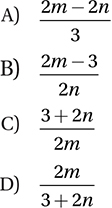
Exercise Set 2 (Calculator)
Let m be a positive real number. Increasing m by 60% and then decreasing the result by 50% is equivalent to dividing m by what number?

What is the sum of the first 50 positive even integers?

Three years ago, Nora was half as old as Mary is now. If Mary is four years older than Nora, how old is Mary now?

If 2/3 of the seats at a football stadium were filled at the beginning of the game, and at halftime 1,000 spectators left, leaving 3/7 of the seats filled, what is the total number of seats in the stadium?

If three candy bars and two gumdrops cost $2.20, and four candy bars and two gumdrops cost $2.80, what is the cost, in dollars, of one gumdrop?

If  what is the value of x −1?
what is the value of x −1?

Subtracting 3 from a number and then multiplying this result by 4 is equivalent to multiplying the original number by 4 and then subtracting what number?

In a poker game, a blue chip is worth 2 dollars more than a red chip, and a red chip is worth 2 dollars more than a green chip. If 5 green chips are worth m dollars, then which of the following represents the value, in dollars, of 10 blue chips and 5 red chips?
A) 50 + 3m
B) 18 + 60m
C) 40 + 3m
D) 28 + 20m
A train travels at an average speed of 50 miles per hour for the first 100 miles of a 200-mile trip, and at an average of 75 miles per hour for final 100 miles. What is the train’s average speed for the entire trip?
A) 58.5 mph
B) 60.0 mph
C) 62.5 mph
D) 63.5 mph
Which of the following is equivalent to 3m (m2 × 2m) for all real values of m?
A) 3m2 + 6m
B) 3m2 × 6m
C) 3m3 × 6m2
D) 6m4
If the cost of living in a certain city increased by 20% in the 10 years from 1980 to 1990, and increased by 50% in the 20 years from 1980 to 2000, what was the percent increase in the cost of living from 1990 to 2000?
A) 15%
B) 20%
C) 25%
D) 30%
EXERCISE SET 2 ANSWER KEY
No Calculator
1. 29 4 pounds 5 ounces = 4(16) + 5 = 69 ounces, and 6 pounds 2 ounces = 6(16) + 2 = 98 ounces. Therefore, bag B weighs 98 − 69 = 29 ounces more.
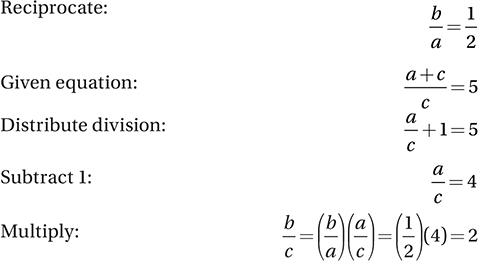
Calculator
12. 1.25 Increasing a number by 60% is equivalent to multiplying it by 1.60, and decreasing a number by 50% is equivalent to multiplying it by 0.50. Therefore, performing both changes in succession is equivalent to multiplying by 1.60 × 0.50 = 0.80. Multiplying by 0.80 is equivalent to dividing by its reciprocal: 1/(0.80) = 1.25.
13. 2,550 The sum of the first 50 positive even integers is 2 + 4 + 6 + 8 + … + 100. As with the example in Lesson 2, these numbers can be regrouped into 25 pairs of numbers each of which has a sum of 2 + 100 = 102. Therefore, their sum is 25(102) = 2,550.
14. 14 Let n = Nora’s age now, and m = Mary’s age now. If 3 years ago, Nora was half as old
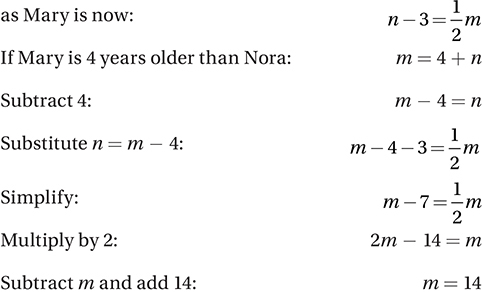
15. 4,200 Let x = the total number of seats in the
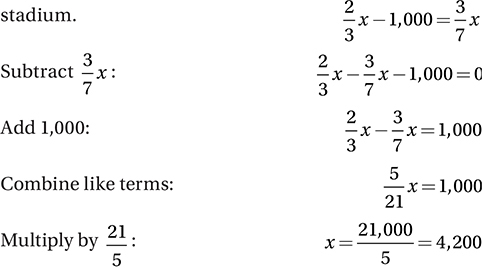
16. 0.20 Let g = the cost, in dollars, of one gumdrop, and c = the cost, in dollars, of one candy bar.
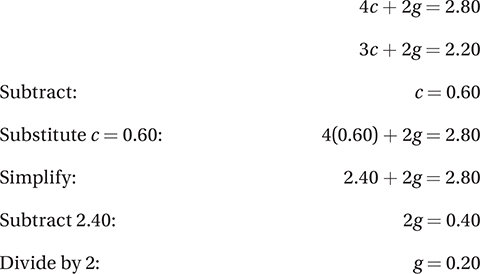
18. 12 We can just choose a number to work with, like 10. If we subtract 3 from this number then multiply the result by 4, we get 4(10 − 3) = 28. If we multiply it by 4 and then subtract a mystery number, we get 4(10) − x = 40 − x .28 = 40 − x

19. A If 5 green chips are worth m dollars, then each green chip is worth m/5 dollars. If a red chip is worth 2 dollars more than a green chip, then each red chip is worth m/5 + 2 dollars. If each blue chip is worth 2 dollars more than a red chip, then each blue chip is worth m/5 + 4 dollars. Therefore, 10 blue chips and 5 red chips are worth 10(m/5 + 4) + 5(m/5 + 2) = 2m + 40 + m + 10 = 3m + 50 dollars.
20. B The average speed is equal to the total distance divided by the total time. The total distance is 200 miles. The time for the first hundred miles is (100 miles/50 mph) = 2 hours, and the time for the second hundred miles is (100 miles/75 mph) = 4/3 hours. Therefore the total time of the trip is 2 + 4/3 = 10/3 hours, and the average speed is

22. C Assume the cost of living in 1980 was $100. If this increased by 20% from 1980 to 1990, then the cost of living in 1990 was 1.20($100) = $120. If the increase from 1980 to 2000 was 50%, then the cost of living in 2000 was 1.50($100) = $150. The percent increase from 1990 to 2000 is therefore

Lesson 5: Constructing and interpreting linear equations
Linear Equations from Word Problems
When setting up linear equations from word problems, consider which linear form matches the information you are given.
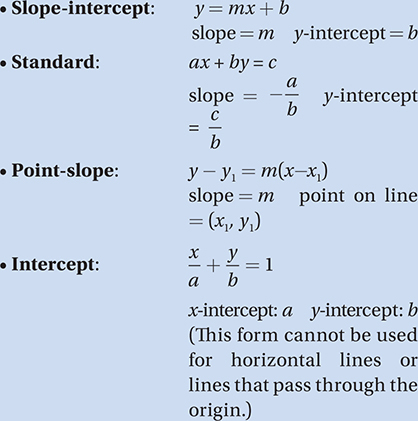
The Horizon Resort charges $150 per night for a single room, and a one-time valet parking fee of $35. There is a 6.5% state tax on the room charges, but no tax on the valet parking fee. Which of the following equations represents the total charges in dollars, C, for a single room, valet parking, and taxes, for a stay of n nights at The Horizon Resort?
A) C = (150 + 0.065n) + 35
B) C = 1.065(150n) + 35
C) C = 1.065(150n + 35)
D) C = 1.065(150 + 35)n
(Easy-medium) Since the room charge is $150 per night, the charge for n nights is $150n . If a 6.5% tax is added to this, the room charge becomes 150n + 0.065(150n ) = 1.065(150n) per night. The $35 valet parking charge is added separately, and not taxed, so the total charges are 1.065(150n) + 35, and the correct answer is B. This is a linear equation in slope-intercept form, in which the slope is the cost per day and the y-intercept is the fixed cost.
Graphing Lines
When working with linear equations, make sure you know how to turn equations into graphs and graphs into equations. In addition to knowing the different forms of linear equations, it helps to know the slope formula.
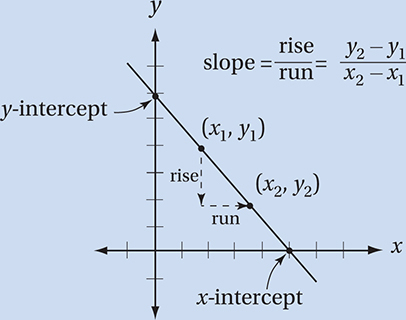
Which of the following represents the equation of the line with an x-intercept of 6 that passes through the point (3, 2)?
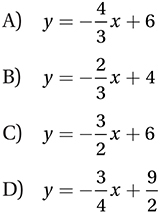
(Easy) Let’s draw a graph of the given information:
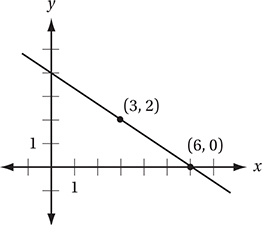
Since we are given two points on the line, (3, 2) and (6, 0), we can calculate the slope using the slope formula:

If we use this slope and the point (6, 0), we can set up the equation in point-slope form:

So the correct answer is B. This equation is in slope-intercept form, and shows that this line also has a y-intercept of 4, matching our graph.
10y = −7(2x − 5)
Which of the following equivalent forms of the linear equation above shows the x- and y-intercepts of its graph in the xy-plane as constants or coefficients?
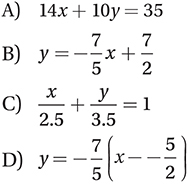
(Medium) Since the question tells us that these are all equivalent forms of the same equation, there is no need to manipulate the given equation. Notice that choice A is in standard form, choice B is in slope-intercept form, and choice D is in point-slope form. Choice C is correct because it is in intercept form. You should be able to confirm that the points (2.5, 0) and (0, 3.5), the x- and y-intercepts, satisfy this equation and that these intercepts are the constants in the equation.
F = 1.8K − 459.4
The formula above can be used to convert any temperature in Kelvin, K, to degrees Fahrenheit, F. Which choice best expresses the meaning of the number 1.8 in this formula?
A) Every increase of 1° Fahrenheit is equivalent to an increase of 1.8 Kelvin.
B) Every increase of 1 Kelvin is equivalent to an increase of 1.8° Fahrenheit.
C) 1.8 Kelvin is equivalent to –459.4° Fahrenheit.
D) 0° Fahrenheit is equivalent to 1.8 Kelvin.
(Medium-hard) This formula is a linear equation in the form y = mx + b, where m is the slope of the line (the change in y for every unit change in x), and b is the y-intercept of the line (the y value when x is 0). Since 1.8 is the slope of the line in this formula, it must be the change in degrees Fahrenheit for every unit change in Kelvin, so the correct answer is B.
F = 1.8K − 459.4
The formula above can be used to convert any temperature in Kelvin, K, to degrees Fahrenheit, F. Which choice best expresses the meaning of the number 459.4 in this formula?
A) A temperature of 0 Kelvin is equivalent to a temperature of –459.4° Fahrenheit.
B) A temperature of 459.4 Kelvin is equivalent to a temperature of 0° Fahrenheit.
C) –459.4 is the lowest value on the Kelvin scale.
D) 459.4 is the highest value on the Fahrenheit scale.
(Medium) When a value of 0 is substituted for K, the temperature in Kelvin, the value of F, the temperature in degrees Fahrenheit, is –459.4. Therefore, the correct answer is A. Choice B is incorrect because when 459.4 is substituted for K, F = 367.52, not 0. Choice C is incorrect because the formula does not indicate a lowest possible value for K. (In fact, scientists define 0 as the lowest possible value of K—this is known as absolute zero—but this fact is not implied by the formula.) Choice D is incorrect because the formula does not imply a highest value for the Fahrenheit scale.
Lesson 6: Solving equations with the Laws of Equality
The Laws of Equality
To solve algebraic equations, you need the Laws of Equality.
1. Whatever you do to change the value of one side of an equation, you must also do to the other side.
2. You may add, subtract, or multiply equal quantities on both sides of any equation at any time.
3. You may divide both sides of any equation by any number except 0. (Because division by 0 is undefined.)
4. If you want to take the square root of both sides of an equation, remember that every positive number has two square roots: one positive and one negative.

(Medium) This doesn’t look like a linear equation, but if we apply Law of Equality #2, we can see that it is.

Notice that the common denominator of the two fractions is 3x, so we can simplify the equation by multiplying both sides by 3x:
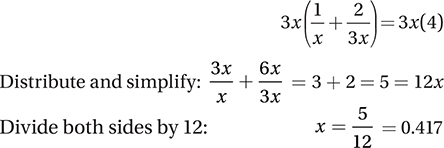
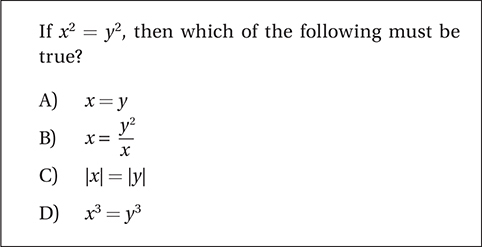
(Hard) You might want to take the square root of both sides of the equation, but remember Law of Equality #4. If x2 = y2, then x and y are either the same number or opposites. For instance, notice that x = 0 and y = 0 is a solution, but these values don’t work for choice B because 0/0 is undefined. Also, x = 1 and y = −1 is a solution, but these values don’t work in choices A or D. Therefore, the correct answer is C.
If 3x2 − 6x − 1 = 0, what is the value of 5x2 − 10x?

(Medium-hard) Although the given equation is quadratic, don’t treat this as a "solve the quadratic" problem, because it’s not asking you to find the values of x. Instead, it asks you to find the value of 5x2 − 10x. At first glance, this may seem harder, but not if you understand the laws of equality. Instead of "getting x" on one side of equation, we should focus on "getting 5x2 − 10x" on one side.
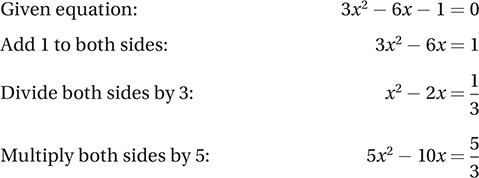
Therefore, the correct answer is C.
Lesson 7: Analyzing Linear Graphs
Thinking about Slopes
It sometimes helps to think of the slope of a line as how much it goes up (or down) when you take one step to the right along the line.
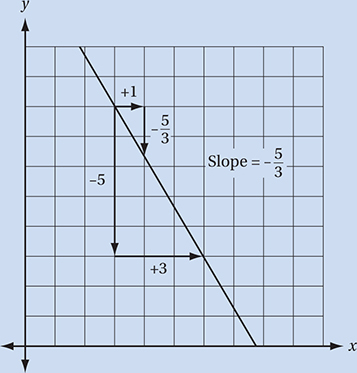
When looking at a linear graph, remember that lines with a positive slope go up as you move to the right, lines with a negative slope go down as you move to the right, and lines with a 0 slope are horizontal.
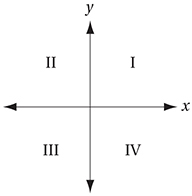
Which of the following equations, when graphed in the xy-plane, contains points in all quadrants except quadrant II?
A) 2x + 5y = 9
B) −2x + 5y = 9
C) 2x − 5y = 9
D) −2x − 5y = 9
(Medium) A line with points in quadrants I, III, and IV must have a positive slope and a negative y-intercept. If we use the formulas from Lesson 5 that tell us how to find the slope and y-intercept of lines in standard form, we can see that only choice C works, because it has a slope of 2/5 and a y-intercept of 9/5.
Parallel and Perpendicular Lines
Parallel lines have equal slopes. Perpendicular lines have slopes that are opposite reciprocals of each other.
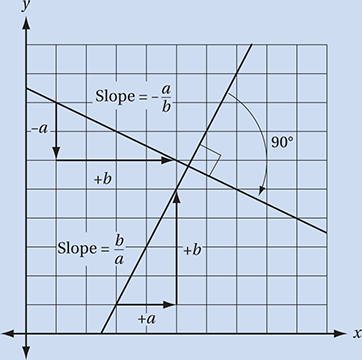
2x − 3ky = 12
4x + 2py = 20
In the equations above, k and p are constants. If the graphs of these equations in the xy-plane are perpendicular lines, what is the value of kp?

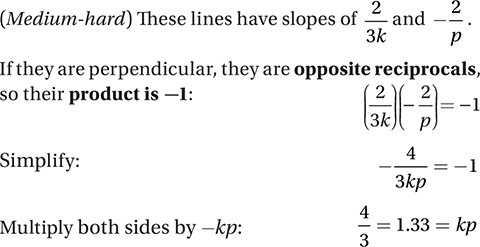
The graph of line λ in the xy-plane passes through the point (2, 5) and has an x-intercept of 7. Which of following gives the equation of a line that is perpendicular to line λ and passes through the point (4, 2)?
A) y = −x + 6
B) y = −x + 4
C) y = x − 2
D) y = x + 2
(Medium-hard) We are told that line λ passes through two points: (2, 5) and (7, 0), so we can calculate its slope:

The slopes of perpendicular lines are opposite reciprocals, so the slope of the new line is 1. The new line must pass through (4, 2), so we can get its equation using the point-slope form of the equation from Lesson 5:

Therefore, the correct answer is C.
x + my + m = 0?
If m is a constant greater than 1, which of the following could be the graph in the xy-plane of the equation above?

(Medium-hard) First, we should try to get the equation into a more useful form. Let’s try the slope-intercept

So the line has a slope of –1/m and a y-intercept of –1. Since m is greater than 1, this slope must be between –1 and 0. The only graph that satisfies these conditions is B.
Exercise Set 3 (No Calculator)
If x − 2(1 − x) = 5, what is the value of x?

If f(x) = −2x + 8, and f(k) = −10, what is the value of k?

What is the slope of the line that contains the points (−2, 3) and (4, 5)?

What is the slope of the line described by the

Line l is perpendicular to the line described by the equation 5x + 11y = 16. What is the slope of line l?


What is the y-intercept of the line containing the points (3, 7) and (6, 3)?

In the xy-plane, the graph of y = h(x) is a line with slope −2. If h (3) = 1 and h (b ) = −9, what is the value of b?

If a train maintains a constant speed of 60 miles per hour, it can travel 4 miles per gallon of diesel fuel. If this train begins a trip with a full 200 gallon tank of diesel fuel, and maintains a speed of 60 miles per hour, which of the following equations represents the number of gallons, g, left in the tank t hours into the trip?
A) 
B) 
C) g = 200 –15t
D) 
The points A (2, 3) and B (m , 11) are 10 units apart. Which of the following equations could describe the line that contains points A and B?
A) 8x + 6y = 11
B) 8x − 6y = −2
C) 6x + 8y = 36
D) 6x − 8y = −12
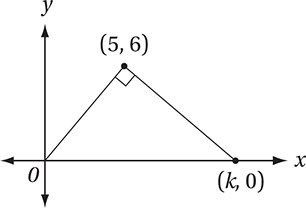
The figure above shows a right triangle with vertices at the origin, (5, 6) and (k, 0). What is the value of k?
A) 
B) 
C) 
D) 
Exercise Set 3 (Calculator)
If the points (2, 4), (5, k ), and (8, 20) are on the same line, what is the value of k?

Line l has a slope of 3 and a y-intercept of −4. What is its x-intercept?

If f(-1) = 1 and f(3) = 2 and f is a linear function, what is the slope of the graph y = f(x)?

If f(-1) = 1 and f(3) = 2 and f is a linear function, what is f(5)?

In the xy-plane, the graph of line n has an x-intercept of 2b and a y-intercept of −8b, where b ≠ 0. What is the slope of line n?

If  , what is the value of x?
, what is the value of x?

If the line 3x- 2y = 12 is graphed in the xy-plane, what is its x-intercept?

If the graphs of the equations 5x − 2y = 5 and 6x + ky = 9 are perpendicular, what is the value of k?

The net profit for the sales of a product is equal to the total revenue from the sales of that product minus the total cost for the sales of that product. If a particular model of calculator sells for $98, and the cost for making and selling n of these calculators is $(35n + 120,000), which of the following equations expresses the net profit in dollars, P, for making and selling n of these calculators?
A) P = 63n − 120,000
B) P = 63n + 120,000
C) P = 63(n − 120,000)
D) P = 63(n + 120,000)
Which of the following represents the equation of the line with an x -intercept of 5 and a y-intercept of 6?
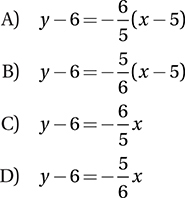

The table above shows several ordered pairs corresponding to the linear function f. What is the value of a + b?
A) 12
B) 16
C) 20
D) It cannot be determined from the information given.
EXERCISE SET 3 ANSWER KEY
Part 1: No Calculator



5. 11/5 or 2.2 The slope of the given line is −5/11, so the slope of the line perpendicular to it is 11/5.
7. 11 There are a variety of ways of solving this problem, but perhaps the simplest is to draw a quick sketch:
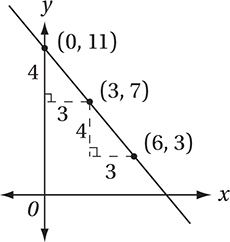
Notice that to get from (6, 3) to (3, 7) we must go left 3 units and up 4 units (in other words, the slope is −4/3). If we simply repeat this from (3, 7), we arrive at the y-intercept, which is (0, 11).
8. 8 This line has a slope of −2 and contains the points (3, 1) and (b , −9). Therefore 

9. C Since the tanks starts with 200 gallons, the amount it has left is 200 − the number of gallons used. The number of gallons used is

10. B Once again, a quick sketch can be very helpful. Notice that traveling from point
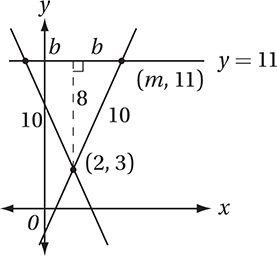
A(2, 3) to point B(m, 11) requires going up 8 units and right (or left) some unknown distance b. We can find b with the

Therefore, m is either 2 − 6 = −4 or 2 + 6 = 8, and the slope of this line is either 8/6 = 4/3 or 8/(-6) = −4/3. The only equation among the choices that is satisfied by the ordered pair (2, 3) and has a slope of either 4/3 or −4/3 is B.
11. D Recall that the slopes of perpendicular lines are opposite reciprocals. The slope of the segment from (0, 0) to (5, 6) is 6/5, so the slope of its perpendicular is −5/6.

Part 2: Calculator
12. 12 The slope of this line is  .
.

13. 4/3 or 1.33 Since the slope and y-intercept are given, it is easy to express the linear equation in slope-intercept form: y = 3x − 4.
The x-intercept is the value of x on the line for

14. ¼ or .25 The line contains the points (-1, 1) and (3, 2), so its slope is  .
.
15. 5/2 or 2.5 Although we could solve this problem by deriving the linear equation, it is perhaps easier to take advantage of the result from question 14. The slope of 1/4 means that the y-coordinate of any point on the line increases by 1/3 each time the x-coordinate increases by 1. Since the x-coordinate increases by 2 between f (3) and f (5), the y-coordinate must therefore increase by 2(1/4) = 1/2, so f (5) = 2 + ½ = 2.5.
16. 4 The line contains the points (2b, 0) and (0, −8b); therefore, it has a slope of  .
.
18. 4 The x-intercept is the value of x for which

19. 15 Recall that the slope of a line in standard form ax + by = c is -a/b. Therefore, the slope of 5x − 2y = 5 is 5/2 and the slope of 6x + ky = 9 is −6/k. If these lines are perpendicular, then their slopes are opposite reciprocals:

20. A The total revenue for selling n calculators at $98 each is $98n, and the cost for making and selling n calculators is $(35n + 120,000). Therefore the profit is $(98n − 35n − 120,000) = 63n − 120,000 dollars.
21. C This line contains the points (5, 0) and (0, 6) and therefore has a slope of  .
.
Since its y-intercept is 6, its slope-intercept form is  or, subtracting 6 from both sides,
or, subtracting 6 from both sides,  .
.
22. B Since f is a linear function, it has a slope that we can call m. Recall that it’s often useful to think of the slope of a line as the "unit change," that is, the amount that y changes each time x increases by 1. Since the x values increase by 1 with each step in our table, the y values must therefore increase by m with each step. This means that a = 8 − m and b = 8 + m . Therefore, a + b = 8 − m + 8 + m = 16.
Lesson 8: Understanding inequalities and absolute values
Absolute Value as Distance
The absolute value of a number a, written as |a|, is its distance from 0 on the number line. More generally, |a – b| means the distance between a and b on the number line, regardless of which number is greater.
Which of the following represents the distance between d and –10 on the number line?
A) |d − 10|
B) −10|d|
C) |d + 10|
D) |10 − d|
(Easy) Since the distance between a and b is |a − b|, the distance between d and –10 is |d − (−10)| = |d + 10|, so the correct answer is C.
On the real number line, a number, b , is more than twice as far from −3 as it is from 3. Which of the following inequalities can be solved to find all possible values of b?
A) |b − 3| > 2|b + 3|
B) |b + 3| > 2|b − 3|
C) 2|b − 3| > |b + 3|
D) 2|b + 3| > |b − 3|
(Medium) We can translate the statement about b into a statement about distances, and then translate this statement into algebraic language. The original statement is b is more than twice as far from −3 as it is from 3. This can be translated in terms of distances: the distance from b to −3 is more than twice the distance from b to 3. In algebraic language, this translates directly to |b − (−3)| > 2|b − 3| or, more simply, |b + 3| > 2|b − 3|. Therefore, the correct answer is B.
The label on each box of Deer Valley raisins says that it contains 1.25 pounds of raisins, but industry standards allow these boxes to be sold with anywhere from 1.20 pounds to 1.32 pounds of raisins. If x represents the number of pounds of raisins in a box of Deer Valley raisins that meets industry standards, which of the following inequalities represents all possible values of x?
A) |x − 1.25| ≤ 0.05
B) |x − 1.26| ≤ 0.06
C) |x − 1.25| ≤ 0.06
D) |x − 1.26| ≤ 0.05
(Medium-hard) The important fact here is the industry standard, not the label on the box. The standard says that the box can contain any weight of raisins from 1.20 to 1.32 pounds. The midpoint of this range is (1.20 + 1.32)/2 = 1.26 pounds of raisins, and this midpoint is 0.06 from either endpoint of this range. Therefore, x can be any value that is 0.06 or less away from 1.26, which can be stated as |x − 1.26| ≤ 0.06, and so the correct answer is B.
Lesson 9: Solving inequalities with the Laws of Inequality
The Laws of Inequality
The Laws of Inequality are similar to the Laws of Equality, but you have to be careful when multiplying or dividing by a negative.
1. Whatever you do to change the value of one side of an inequality, you must also do to the other side.
2. You may add or subtract anything you want from both sides of an inequality, or multiply or divide by any positive number without changing the direction of the inequality.
3. You may not perform undefined operations to an inequality (such as dividing by 0) or operations that have more than one possible result (like taking a square root).
4. If you multiply or divide both sides by a negative number, you must switch the direction of the inequality. This is because multiplying or dividing by a negative number involves a reflection over the origin, which swaps the relative positions of the numbers:


Given the inequality above, which of the following CANNOT be true?
A) a > −2
B) a > −1
C) a > 1
D) a < 1
(Medium) We need to consider two separate cases: when a is positive and when a is negative.
Case 1: If a > 0, we can multiply both sides by a without

Since we assumed that a > 0, but no positive number can be less than −1/2, this gives us no solution. Therefore, a has no positive solutions. Now look at the choices. Notice that the statement in choice C cannot be true because all values greater than 1 are positive, but this has no positive solutions. Therefore, the correct answer is C. But let’s keep going just to check.
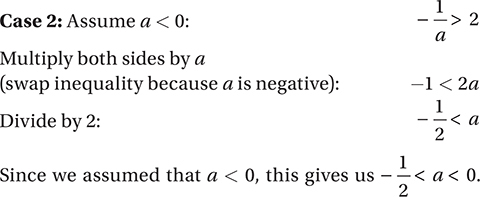
This means values such as −0.4 or −0.3 should work, which you can confirm by plugging in.
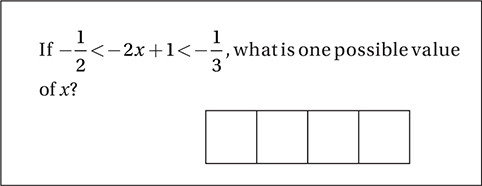
(Medium) This called a “sandwich inequality” because the expression in the middle is "sandwiched" between the other two. Let’s solve for x using the Laws of Inequality.

Multiply all three parts by −6 (the common denominator) and “switch” the direction of the inequalities:

Therefore, any value greater than 0.666 but less than 0.750 is correct.
Which of the following must be true if  ?
?
A) a ≤ − 3b
B) a ≥ − 3b
C) a ≤ − 3b < 0 and a ≥ − 3b > 0
D) a ≤ − 3b < 0 or a ≥ − 3b > 0
(Medium-hard) We might want to multiply by b on both sides, but b might be negative. There are two possibilities:
Case 1: If b > 0, then we don’t switch the inequality when we multiply, so a ≤ −3b, and therefore a ≤ −3b < 0.
Case 2: If b < 0, then we do switch the inequality when we multiply, so a ≥ −3b and therefore a ≥ −3b > 0. So the correct answer is D.
Lesson 10: Graphing inequalities
Analyzing Inequalities with Graphs
To solve problems involving inequalities, it often helps to translate inequalities into graphs, and vice versa.

The graph above shows the solution set of which of the following inequalities?
A) |x − 4| > |x − 1|
B) |x − 4| < |x − 1|
C) |x − 2.5| > 1.5
D) |x − 2.5| < 1.5
(Medium) We could “test” some values on the graph and see if they work in the inequalities. For instance, we can start with x = 0. Since x = 0 is shaded on the graph, it must be a solution of the inequality. However, it clearly doesn’t work for choice B because |0 − 4| < |0 − 1| simplifies to 4 < 1, which is not true. Similarly, we can eliminate choice D because |0 − 2.5| is not less than 1.5. We can continue by process of elimination until we see that only choice C works for the whole set.
However, there is an easier way. Find the midpoint of the graph. The point halfway between 1 and 4 is their average, 2.5. Now, what is true about all of the points in the shaded regions? Since both 1 and 4 are 1.5 units away from 2.5, the shaded regions represent all the points that are more than 1.5 units away from 2.5. In other words, the distance from x to 2.5 is greater than 1.5, which translates to |x − 2.5| > 1.5, which is choice C.
Which inequality represents all numbers on the number line that are closer to 5 than they are to 11?
A) x < 8
B) 5 < x < 11
C) |x − 5| < 11
D) |x − 11| < 5
(Medium) Let’s plot 5 and 11 on the number line and ask, which points are closer to 5 than they are to 11? After some thinking, you should get a picture like this:

which corresponds to choice A.
On the real number line, a number, b, is more than twice as far from −3 as it is from 3. Which of the following graphs represents all possible values of b?
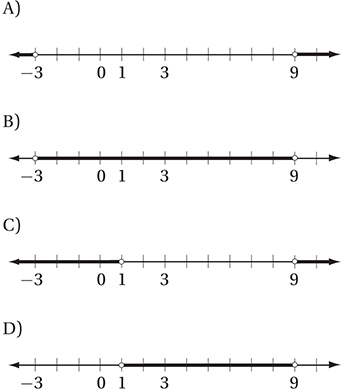
(Medium) We saw this scenario in Lesson 8, but now we are asked to graph the solution. Recall from Lesson 8 that this relationship is expressed by the inequality |b + 3| > 2|b − 3|. How do we translate this into a graph? The simplest way to start is to visualize the number line, and to think about a related, but simpler, question: What if b is exactly twice as far from −3 as it is from 3? A little guessing and checking should reveal that two points work:

Notice that 9 works because 3 is the midpoint between −3 and 9, and 1 works because it is 2/3 of the way from −3 to 3. Also, you can confirm that both numbers satisfy the equation |b + 3| = 2|b − 3|. These two points now divide the line into three parts: everything less than 1, everything between 1 and 9, and everything greater than 9. A little bit of checking (just pick a number from each portion and plug it into our inequality) confirms that only the numbers in the middle portion satisfy our inequality, so the correct graph is the one in choice D.
When graphing inequalities, it often helps to start with the graph of the corresponding equation and work from there. The graph of the equation usually provides the boundaries for the graph of the inequality.
Exercise Set 4 (No Calculator)
What positive number is twice as far from 10 as it is from 1?

If the points (2, a) and (14, b) are 20 units apart, what is |a − b|?

What is the least integer n for which 

If |x + 4| = |x − 5|, what is the value of x?

What is the greatest integer value of n such that 

What is the only integer b for which  and 3b ≥ 7.5?
and 3b ≥ 7.5?

If (b + 2)2 = (b − 5)2, what is the value of b?

Which of the following statements is equivalent to the statement −4 < 2x ≤ 2?
A) x > −2 and x ≤ 1
B) x < −2 or x ≥ 1
C) x ≥ −2 and x < 1
D) x ≤ −2 or x > 1
The annual profit from the sales of an item is equal to the annual revenue minus the annual cost for that item. The revenue from that item is equal to the number of units sold times the price per unit. If n units of a portable heart monitor were sold in 2012 at a price of $65 each, and the annual cost to produce n units was $(20,000 + 10n), then which of the following statements indicates that the total profit for this heart monitor in 2012 was greater than $500,000?
A) 500,000 < 55n − 20,000
B) 500,000 > 55n − 20,000
C) 500,000 < 55n + 20,000n
D) 500,000 < 75n − 20,000n
Colin can read a maximum of 25 pages an hour. If he has been reading a 250 page book for h hours, where h < 10, and has p pages left to read, which of the following expresses the relationship between p and h?
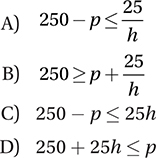
On the real number line, a number, x, is more than 4 times as far from 10 as it is from 40. Which of the following statements describes all possible values of x?
A) x < 34 or x > 50
B) x > 40
C) 34 < x < 50
D) 32.5 < x < 160
Exercise Set 4 (Calculator)
If a < 0 and |a − 5| = 7, what is |a|?

If n is a positive integer and 16 < |6 − 3n| < 19, what is the value of n?

What is the only integer n such that 20 − 2n > 5 and 

What is the smallest number that is as far from 9.25 as 3 is from −1.5?

If |2x + 1| = 2|k − x|, for all values of x , what is the value of |k|?

Which of the following is equivalent to the statement |x − 2| < 1?
A) x < 3
B) x < −1
C) 1 < x < 3
D) −1 < x < 3
If the average (arithmetic mean) of a and b is greater than the average (arithmetic mean) of c and 2b, which of the following must be true?
A) b > 0
B) a > b
C) a > b + c
D) a + c > b
Of the statements below, which is equivalent to the statement "The distance from x to 1 is greater than the distance from x to 3?
A) 1 < x < 3
B) x > 2
C) x < 2
D) x − 1 > 3
Which of the following is equivalent to the statement 4x2 ≥ 9?
A) 2x > 3
B) x ≥ 1.5 or x ≤ −1.5
C) |x| > 2
D) −1.5 ≤ x ≤ 1.5

The graph above indicates the complete solution set to which of the following statements?
A) |x − 3| > 3
B) |x| < 6
C) |x − 6| < 6
D) |x − 3| < 3
Which of the following is true for all real values of x?
A) |x| > 0
B) x < 2 or x > 1
C) x > −2 or x < −3
D) x2 − 1 > 0
EXERCISE SET 4 ANSWER KEY
No Calculator
1. 4 It is helpful to plot these values on the number line and think:

The distance between 1 and 10 is 9, so clearly the number that is 9 more units to the left of 1, namely −8, is twice as far from 10 as it is from 1. However, this is a negative number so it can’t be our answer. There is one other number that is twice as far from 10 as it is from 1: the number that is 1/3 the distance from 1 to 10. This number is 4, which is 3 units from 1 and 6 units from 10.
2. 16 From the Distance Formula,

3. 8 
Since n must be positive for this statement to be true, we can multiply by 9n without having to “swap” the inequality symbols:

Therefore, the smallest integer value of n is 8.
4. ½ or .5 Two numbers, a and b, have the same absolute value only if they are equal or opposites. Clearly x + 4 and x − 5 cannot be equal, since x − 5 is 9 less than x + 4. Therefore they must be opposites.

Therefore, the greatest possible integer value of n is 10.
Since b is greater than or equal to 2.5, it is positive, so we can multiply both sides by 11b without “swapping” the inequality:

The only integer between 2.5 and 3.67 is 3.
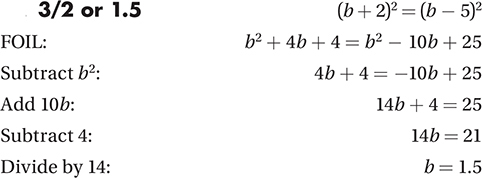
which is equivalent to −2 < x and x ≤ 1.
9. A The profit is the revenue minus the cost: 65n − (20,000 + 10n) = 55n − 20,000.
10. C If Colin can read a maximum of 25 pages an hour, then in h hours he can read a maximum of 25h pages. If he has p pages left in a 250-page book, he has read 250 − p pages. Since it has taken him h hours to read these 250 − p pages, 250 − p ≤ 25h.
11. C |x − 10| > 4|x − 40|
It helps to sketch the number line and divide is into three sections: the numbers less than 10, the numbers between 10 and 40, and the numbers greater than 40.
CASE 1: x < 10. It should be clear that all numbers less than 10 are closer to 10 than they are to 40, so this set contains no solutions.
CASE 2: 10 < x ≤ 40. If x is between 10 and 40, x − 10 is positive and x − 40 is negative, so |x − 10| = x − 10 and |x − 40| = -(x − 40).
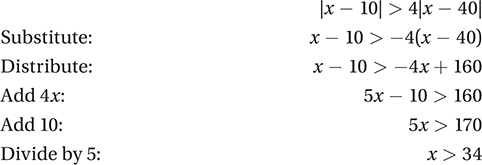
So this gives us 34 < x ≤ 40.
CASE 3: x > 40. If x is greater than 40, then both x − 10 and x − 40 are positive, so |x − 10| = x − 10 and |x − 40| = x − 40.
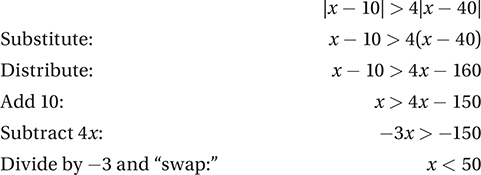
So this gives us 40 < x < 50. When we combine this with the solutions from CASE 2, we get 34 < x < 50.
Calculator
12. 2 If |a − 5| = 7, then either a − 5 = 7 or a − 5 = −7, so either a = 12 or a = −2. Since a < 0, a must be −2, and |−2| = 2.
13. 8 CASE 1: If 6 − 3n is positive, then

But this contradicts the fact that n is positive.
CASE 2: If 6 − 3n is negative, then

And the only integer in this range is n = 8.
Since n must be an integer between 6 and 7.5, n = 7.
15. 4.75 The distance from 3 to −1.5 is |3-(-1.5)| = 4.5. Therefore the two numbers that are 4.5 away from 9.25 are 9.25 + 4.5 = 13.75 and 9.25 − 4.5 = 4.75.
16. ½ or .5 If the equation is true for all values of x, let’s choose a convenient value for x,
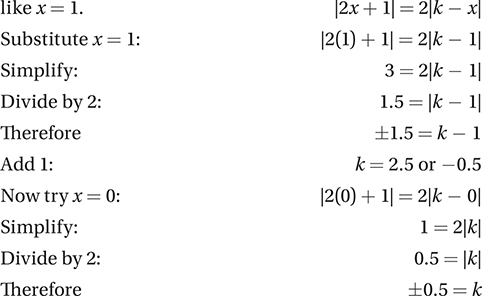
Therefore, k = −0.5 and so |k| = |-0.5| = 0.5.
17. C Recall that the expression |x − 2| means "the distance from x to 2," so the statement |x − 2| < 1 means "The distance from x to 2 is less than 1." Therefore, the solution set is all of the numbers that are less than 1 unit away from 2, which are all the numbers between 1 and 3.
19. B The formal translation of this statement is |x − 1| > |x − 3|, which we can solve algebraically by considering three cases: (I) x ≤ 1, (II) 1 < x ≤ 3, and (III) x > 3, but it is probably easier to just graph the number line and notice that the midpoint between 1 and 3, that is, 2, is the point at which the distance to 1 and the distance to 3 are equal. Therefore, the points that are farther from 1 than from 3 are simply the points to the right of this midpoint, or x > 2.
21. D Notice that the midpoint of the segment shown is 3, and the graph shows all points that are less than 3 units in either direction. Therefore, |x − 3| < 3.
22. B (A) is untrue if x = 0, (C) is untrue for x = −2, and (D) is untrue if x = 0.5. But (B) is true for any real number.
Lesson 11: Constructing, graphing, and interpreting linear systems
A system of equations is just a set of equations that apply simultaneously to a given problem situation. Solving for the system means finding all sets of values for the unknowns that make all of the equations true. Systems of equations can be analyzed both algebraically (by exploring the equations) or geometrically (by exploring the graphs).
Two high school teachers took their classes on a field trip to a museum. One class spent $154 for admission for 20 students and 3 adults, and the other class spent $188 for admission for 24 students and 4 adults. Which of the following systems of equations could be solved to determine the price of a single student admission, s, and the price of a single adult admission, a, in dollars?
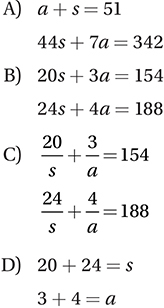
(Medium) This problem can be described with a two-by-two system of equations, that is, two equations with two unknowns. The two equations come from two facts: one class spent $154 for admission and the other class spent $188 for admission. The cost of 20 student admissions and 3 adult admissions is 20s + 3a, so the first equation is 20s + 3a = 154. Similarly, the equation for the other class is 24s + 4a = 188, so the correct answer is (B).
y = 2x − 3
y = −2x + 17
If the solutions to the two equations above are graphed in the xy-plane, what is the y-coordinate of the point at which the graphs intersect?

(Easy) Since the equations of both lines are given in slope-intercept form, we could graph the two lines in the xy-plane to find their point of intersection.
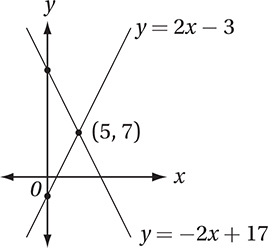
Therefore, the point (5, 7) gives us the only solution to this system, and so the answer to the original question is 7.
Alternately, (as we will see in Lesson 13) we can just add the corresponding sides of the two equations together to get 2y = 14, which yields y = 7.
The solution of a two-by-two system of equations can be visualized as the intersection of their graphs in the xy-plane.
If the graphs are parallel lines, or other non-intersecting graphs, then the system has no solution. If the graphs intersect multiple times, then the system has multiple solutions.
y − 4x = 6
16x = 4y + k
For what value of k does the system of equations above have at least one solution?
A) −32
B) −30
C) −24
D) −20
(Medium) This is a two-by-two system of linear equations, and so its solution is the intersection of those two lines. If we convert them to slope-intercept form, we get y = 4x + 6 and y = 4x − k/4, which reveals that these two lines have the same slope. This means that they are either parallel lines or identical lines. Two lines with the same slope can intersect only if they are the same line, and therefore −k/4 = 6 and k = −24.
Lesson 12: Solving systems by substitution
Let’s go back to the second linear system from Lesson 11. This system can also be solved with a simple application of the Law of Substitution.
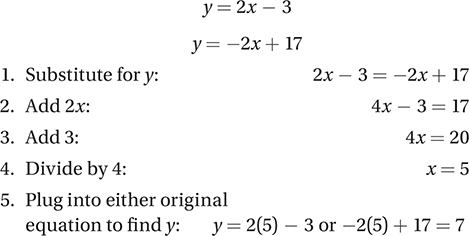
When one of the equations in a system is already solved for one variable (or when it’s relatively easy to solve it for one variable), then substituting for this variable in the other equation often makes it easier to solve the system.
3x + y = 3y + 4
x + 4y = 6
Based on the system of equations above what is the value of xy?

(Medium) This system is not quite as tidy as the previous one, but we can still solve it by using the Law of Substitution.

Subtract 4y from second equation to
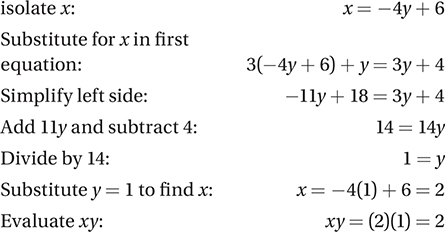
Lesson 13: Solving systems by linear combination
3x + 6y = 18
3x + 4y = 6
Based on the system of equations above, what is the value of y?

(Easy) Although this system can be solved by substitution (try it as an exercise), the setup of these equations suggests a much easier method, known as linear combination. It’s based on a simple idea:
The Law of Combination
If a = b and c = d, then a + c = b + d, a − c = b − d, and ac = bd
In other words, you should always feel free to add, subtract, or multiply the corresponding sides of two equations to make a new equation.
If we apply this rule to our system, notice that we can easily eliminate x from the system by just subtracting the equations:

3x − y = 20
2x + 4y = 7
Based on the system of equations above, what is the value of x − 5y?

(Medium) This question looks tougher than the previous one, because it’s not just asking for x or y. It seems that the question requires us to solve the system for x and y and then to plug these values into the expression x − 5y and evaluate. We could do that, but there is a much simpler method. Notice that a simple combination gives us the expression the question is asking for.

Using Linear Combination
When you’re given a system of equations on the SAT, always notice carefully what the question is asking you to evaluate. Even if it appears to be the value of a complicated expression, often you can find it with a simple combination of the given equations.
Exercise Set 5 (No Calculator)
If 3x + 2y = 72, and y = 3x , what is the value of x?

If 2a − 7b = 10 and 2a + 7b = 2, what is the value of 4a2- 49b2?

If the lines y = −4x − 3 and y = −3x − b intersect at the point (-1, c ), what is the value of b?

If the lines 4x + 5y = 13 and 4y + kx = 2 are parallel, what is the value of k?

If the lines 4x + 5y = 13 and 6y − kx = 6 are perpendicular, what is the value of k?


Based on the system of equations above, what is the value of  ?
?

If ab = −4 and abc = 12, what is the value of  ?
?

If a and b are constants and the graphs of the lines 2x − 3y = 8 and ax + by = 2 are perpendicular, then what is the value of  ?
?

5x − y = 11
2x − 2y = 9
Based on the system of equations above, what is the value of 3x + y?
A) −2
B) 0
C) 2
D) 4
Two numbers have a difference of 4 and a sum of −7. What is their product?
A) −33
B) −10.25
C) 8.25
D) 10.25
It costs Emma p dollars to make each of her custom bracelets, which she sells for m dollars apiece. She makes a profit of $60 if she makes and sells 5 of these bracelets, but she only makes a profit of $10 if she makes 5 bracelets but only sells 4 of them. How much does it cost Emma to make each bracelet?
A) $36
B) $38
C) $48
D) $50
Exercise Set 5 (Calculator)
If 2y = x + 1 and 4x + 6y = 0, then y =


2x − 5y = 20
10x − 25y = 4k
For what value of k does the system of equations above have at least one solution?

At the beginning of the week, the ratio of cats to dogs at Glenna’s Pet Store was 4 to 5. By the end of the week, the number of cats had doubled, while the number of dogs had increased by 12. If the ratio of cats to dogs at the end of the week was 1 to 1, how many cats did the store have at the beginning of the week?

Jenny originally had twice as many friendship bracelets as Emilie. After Jenny gave Emilie 5 of her friendship bracelets, Jenny still had 10 more than Emilie. How many friendship bracelets did Jenny have originally?

The average (arithmetic mean) of x and y is 14. If the value of x is doubled and the value of y is tripled, the average (arithmetic mean) of the two numbers remains the same. What is the value of x?

7m + 10n = 7
6m + 9n = 1
Based on the system of equations above, what is the value of 4m + 4n?

In the xy-plane, perpendicular lines a and b intersect at the point (2, 2). If line a contains the point (7, 1), which of the following points is on line b?
A) (0, 1)
B) (4, 5)
C) (7, 3)
D) (3, 7)
Which of the following pairs of equations has no solution in common?
A) 2x − 3y = 1 and 6x − 9y = 3
B) y = 4x and y = −4x
C) 2x − 3y = 1 and 6x − 9y = 2
D) y = 4x and 2y − 8x = 0
In the xy-plane, the line l is perpendicular to the line described by the equation  . What is the slope of line l?
. What is the slope of line l?

EXERCISE SET 5 ANSWER KEY
No Calculator
4. 3.2 or 16/5 Parallel lines must have equal slopes. The slope of 4x + 5y = 13 is −4/5, and the slope of 4y + kx = 2 is -k/4.

5. 7.5 or 15/2 Perpendicular line have slopes that are opposite reciprocals. The slope of 4x + 5y = 13 is −4/5, and the slope of 6y − kx = 6 is k/6.
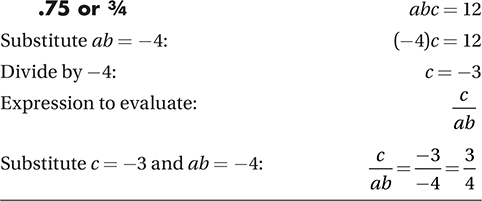
8. 4.5 or 9/2 The slope of 2x − 3y = 8 is 2/3, and the slope of ax + by = 2 is − a/b. If the two lines are perpendicular, then the slopes are
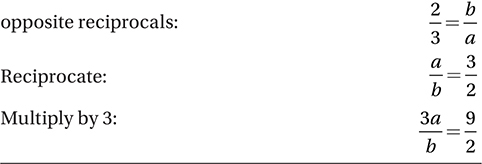
Calculator

19. D Line a contains the points (2, 2) and (7, 1); therefore, it has a slope of  . If line b is perpendicular to line a, then it must have a slope of 5 (the opposite reciprocal of −1/5). You might find it helpful to sketch the line with slope 5 through the point (2, 2), and confirm that is passes through the point (3, 7), which is one unit to the right and one 5 units up.
. If line b is perpendicular to line a, then it must have a slope of 5 (the opposite reciprocal of −1/5). You might find it helpful to sketch the line with slope 5 through the point (2, 2), and confirm that is passes through the point (3, 7), which is one unit to the right and one 5 units up.
20. C In order for two lines in the xy-plane to have no points in common, they must be parallel and nonidentical. The only two such lines among these choices are 2x − 3y = 1 and 6x − 9y = 2, which both have a slope of 2/3, but have different y-intercepts of −1/3 and- 2/9.
This line has a slope of 1/2, so the perpendicular must have a slope of −2.
